18 World-Class Course Modules: Click the headings below for an overview of each module
Module One: Introduction to Writing Children’s Stories
Module Overview
- Introduction to writing children’s stories
- Getting started
- Tips from successful children’s authors
- How JK Rowling became a successful author
- The Three C’s
- The 5 practical elements that produce page-turning fiction
- The planning stage
- How to pitch your story
- Mapping Chapters
- How to create character identities
- How to plan the timing of a Story
- The three major elements of a satisfying piece of fiction
- Setting
- Relationships between characters and settings
- Viewpoint
- Past, present and future tense
- Identifying your ‘voice’.
- How to start the first chapter
- How to create the first draft
- Setting the tone
- Common mistakes most beginners make
- Self-assessment test
- Much more!
Sample Screenshots
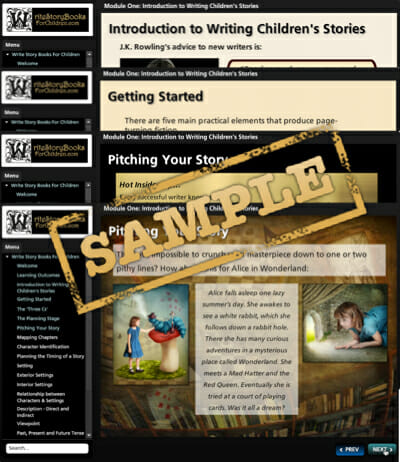
Module Two: Age Groups & Story Types (click to open)
Module Overview
- Choosing the right type of book
- Choosing an age group
- Writing for children under 7
- How to write preschool books
- How to write books for infants
- Writing for 7 – 11 year olds
- Matching vocabulary and plot
- Writing for teens and young adults
- Writing animal stories
- Writing school stories
- Writing sports stories
- Writing historical stories
- Writing adventure stories
- Writing mystery stories
- Creating 3-dimensional villains and heroes
- Writing humor
- Creating weird and wonderful characters
- Writing science fiction and fantasy
- Writing short stories
- Submission guidelines
- Researching your market
- Common mistakes and how to avoid them
- Creating short stories with a twist
- Much more!
Sample Screenshots
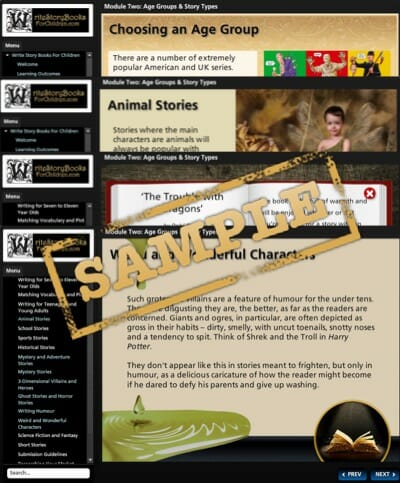
Module Three: Choosing & Developing Your Setting (click to open)
Module Overview
- Choosing and developing your setting
- Writing historical settings
- Using weather and climate
- Authors tool:a weather diary
- Writing effective weather and historical stories
- How to infuse your writing with emotional atmosphere
- Using all the senses
- Changing the pace of your writing
- How to write night time scenes for children
- Using the setting as a backdrop to the action
- Researching like a professional
- Hiring a professional researcher
- Historical research
- Theme parks
- Using press offices
- General reference books
- Setting up a system for your research material
- Writing from your research material
- Common mistakes amateurs make
- Self-assessment test
- Much more!
Sample Screenshots
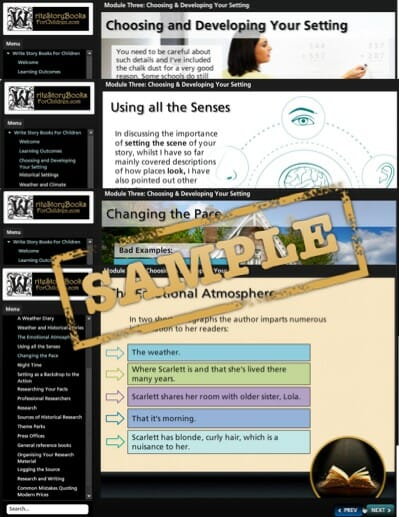
Module Four: Developing Credible Characters (click to open)
Module Overview
- Identifying key factors for developing credible characters
- Combining characteristics
- Role reversal
- Unfolding the character
- Show, Don’t Tell
- Four vital elements of characterisation
- Using tags to mark your fictional characters
- Using displacement activity
- Using NLP to develop your characters
- Body language
- Transactional analysis
- Games people play
- Reasons behind actions
- Choosing the right names for your characters
- Syllables
- Heroes and heroines
- Character gaccordion-containerth
- Believability
- The seven deadly sins
- Secondary characters
- Writing with worldwide selling rights in mind
- Market demands
- Common mistakes
- Much more!
Sample Screenshots

Module Five: Writing Dialogue (click to open)
Module Overview
- Writing dialogue
- Dialogue and real conversation
- Locality in dialogue
- Regional dialects
- Foreigners
- Sentence structures for foreign characters
- NLP and Dialogue
- Character differentiation
- Distance yourself from your characters
- How often to identify the speaker
- Period dialogue
- Period attitudes
- Humor in dialogue
- How to present dialogue
- Common mistakes
- Lots of practical tips and techniques
- Interactive elements for an enhanced learning experience
- Self-assessment test
- Much more!
Sample Screenshots
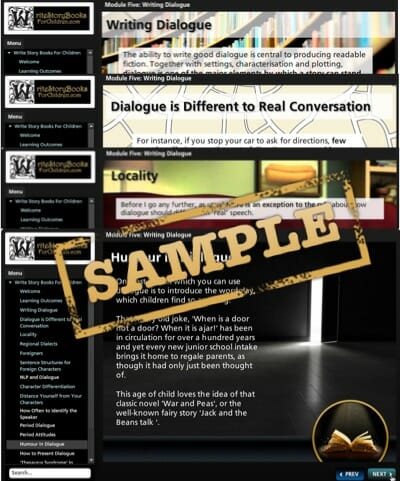
Module Six: Plotting, Storyline & Theme (click to open)
Module Overview
- Plotting your story
- Storyline
- Theme
- What is a plot
- Stories for the under eight year olds
- Make your story plausible
- Looking closely at your ideas
- The creative process of writing
- Spider diagrams
- Change of pace
- Using ‘Think Pieces’
- Security
- Reality in fiction
- Building climaxes
- Always deliver
- Character identification
- Endings
- Prospecting for ideas
- Using your notes
- Inspiration from other writers work
- Common mistakes – using clichés
- Lots of practical tips and techniques
- Interactive elements for an enhanced learning experience
- Self-assessment test
- Much more!
Sample Screenshots
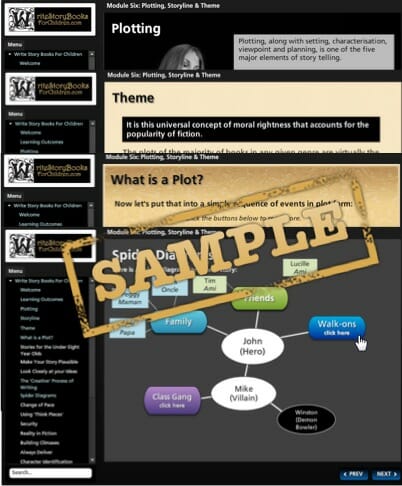
Module Seven: Writing Picture Books for Children (click to open)
Module Overview
- Writing for the Under Sevens
- The rewards
- The development of language – the early months of a baby’s life
- The development of language – from 3 years on
- The development of language – age 4 and upwards
- Linking technical factors and age requirement
- Adding suspense
- Familiar topics
- Reading schemes
- Avoid the abstract
- Repetition
- The over-fives
- Worldwide sales and political correctness
- Using animals
- Working with illustrators
- Producing artwork
- Illustrations for non-fiction books
- The front cover
- The sales department
- Common mistakes
- Lots of practical tips and techniques
- Interactive elements for an enhanced learning experience
- Self-assessment test
- Much more!
Sample Screenshots
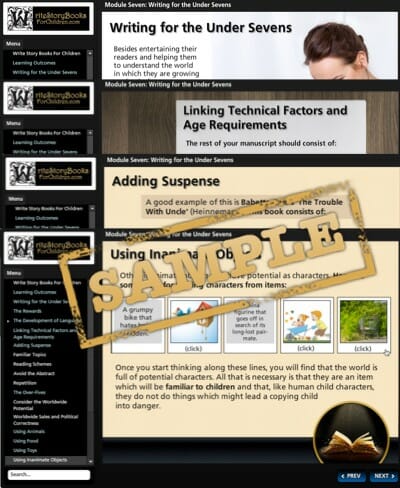
Module Eight: Writing for Seven to Twelve Year Olds (click to open)
Module Overview
- Writing for seven to twelve year olds
- How long should your book be?
- The market place
- Illustrations for seven to twelve year olds
- Details of the modern world
- Humour
- Justice and revenge
- Adventure
- Witches and wizards
- Social and environmental issues
- History
- Keeping up the pace
- Actions and emotions
- Showing relationships
- Weaving the strands of a story
- Coincidences
- Sub-plots
- Children’s books and gender
- Archetypal baddie and the wolf
- Horror stories
- Pet themes
- Common mistakes – lecturing your readers
- Lots of practical tips and techniques
- Interactive elements for an enhanced learning experience
- Self-assessment test
- Much more!
Sample Screenshots
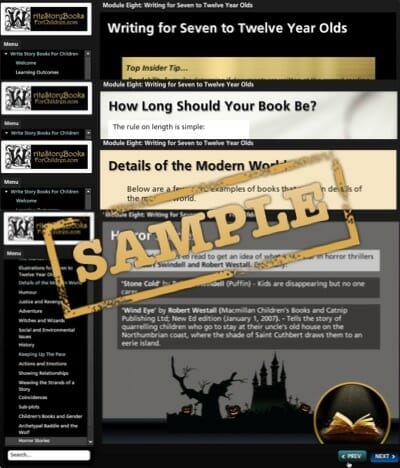
Module Nine: Writing Young Adult Fiction (click to open)
Module Overview
- Writing for teenagers
- Market research
- Themes
- Applying the standard rules
- Suspense
- Mysteries and thrillers
- How to create cliff-hangers
- Planting the seeds of doubt
- Red herrings
- Letting your teenage characters solve the mysteries
- Keeping readers guessing
- Romance
- Settings for romantic stories
- Teenagers 3, rest of world 0
- The teenagers world
- Boy meets girl
- The role of music in teenagers’ lives
- Teenage magazine fiction
- Settings
- The confession story
- Common mistakes:showing off
- Lots of practical tips and techniques
- Interactive elements for an enhanced learning experience
- Self-assessment test
- Much more!
Sample Screenshots
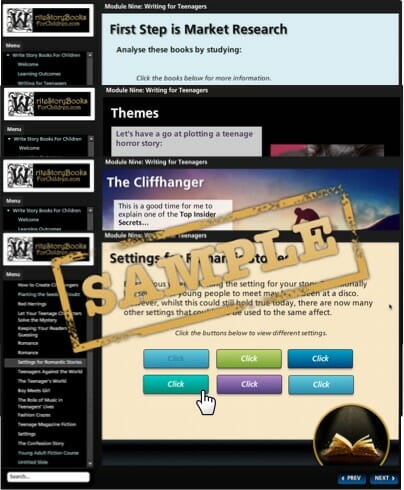
Module Ten: Writing Fantasy and Science Fiction for Children (click to open)
Module Overview
- Writing fantasy and science fiction
- Setting
- How to build a new world:mountains, swamps and caves
- Techniques for naming and populating a new world
- Techniques for naming plants
- Techniques for naming alien creatures
- Fantasy
- Fantasy folk stories
- Good versus evil in modern settings
- Ultra modern fantasies
- Fantasy for the youngest readers
- Fantasy for the middle-age-band readers
- Dungeons and dragons
- The battle between good and evil
- Science fiction
- Social organisation
- Time travel
- Alien worlds and creatures
- Science fiction research
- Religion and morals in other worlds
- Device names
- Lots of practical tips and techniques
- Interactive elements for an enhanced learning experience
- Self-assessment test
- Much more!
Sample Screenshots
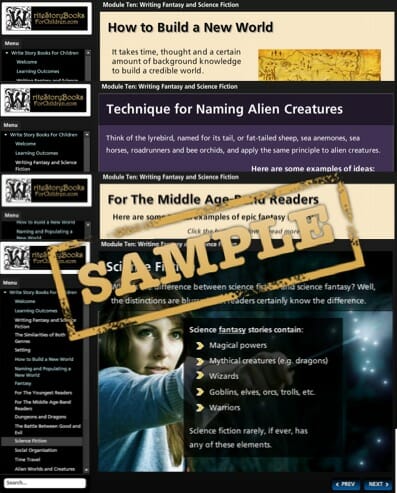
Module Eleven: Writing Non-Fiction for Children (click to open)
Module Overview
- Writing non-fiction
- Ready-made market
- Other information books
- Other non-fiction books
- Information books format
- Payment
- Working with a team
- Proposal and outline
- Sample chapters
- Biographies
- Research
- Quotations
- Techniques
- Tables
- Religion
- Gender
- Characters and non-fiction
- Non-fiction for magazines
- Payment
- Multi-media – storybook apps
- Lots of practical tips and techniques
- Interactive elements for an enhanced learning experience
- Self-assessment test
- Much more!
Sample Screenshots

Module Twelve: Writing Drama and Screenplays for Children (click to open)
Module Overview
- Writing for other media
- Financial rewards
- Professional theatre
- Agents and fees
- Dialogue
- Pace and action
- Plays for radio
- Production costs and you, the writer
- Drama for television
- Script changes
- Costs
- The techniques of play writing
- The function of the driver
- The stages of planning
- Acts
- Scenes
- Segments
- Beats
- Writing for puppet theatres
- Book adaptations for radio or television
- Writing picture strips for magazines
- Subjects
- Copyright
- Early years
- Older children and teenagers
- Each frame
- Editing
- Romantic picture strips
- Contracts for dramatic works
- Presenting your script
Sample Screenshots
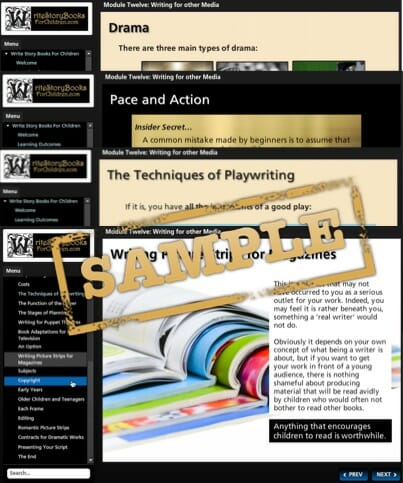
Module Thirteen: Writing Secrets of Successful Children’s Authors (click to open)
Module Overview
- Your work place
- The importance of ritual
- Work routine
- The power of discipline
- Overcoming procrastination
- Helpful devices
- Writing methods
- Developing a good style
- Create unusual images
- Revision and renewed viewing
- First drafts
- Stages of revision
- Second draft
- Word editing
- The final proof read
- A lesson in general grammar
- Titles
- Working titles
- Non-fiction book titles
- Check out working timetable
- Joining a writers’ group
- Common mistakes – overly manipulating characters and events
- Coping with rejection
- Lots of practical tips and techniques
- Interactive elements for an enhanced learning experience
- Self-assessment test
- Much more!
Sample Screenshots
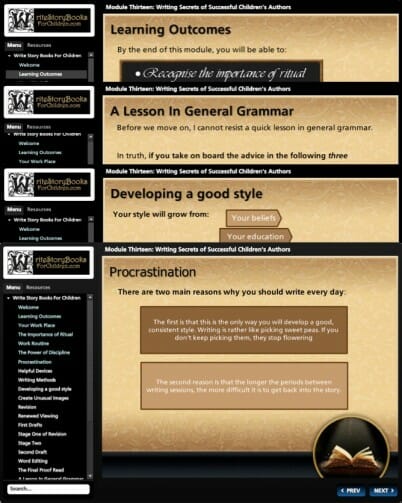
Module Fourteen: Insider’s Guide to Getting Published (click to open)
Module Overview
- Preparing manuscripts for submission
- Submitting your manuscript
- Working with publishers
- Attitude
- Practical solutions
- The offer
- The expert team
- Marketing your book
- Author’s questionnaire
- Marketing – your responsibility
- Publishers contracts and negotiation
- Literary agents
- Track record
- Merchandising agents
- Proposals and outlines for non-fiction books
- The proposal
- The outline
- Publishers’ specific formats
- The covering letter
- Common mistakes – non-fiction books
- Royalties
- Copyright, moral right and public lending right
- Trusting publishers
- Common mistakes – publishers’ requirements
- Common mistakes – vanity publishing
- Self-assessment test
- Much more!
Sample Screenshots
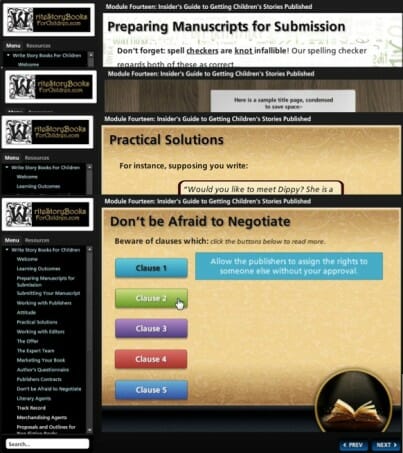
Module Fifteen: Introduction to Self-Publishing (click to open)
Module Overview
- The hybrid author
- Why become a hybrid author
- From one-man publisher to mainstream
- Your choices
- Getting published quickly
- The personal family book
- How a hybrid author self-publishes
- Creating a blockbuster book title
- The good and the bad
- Titles for the Early Years (pre-school)
- Sounds of words
- Titles for 5 – 7 years (first time read-alone)
- The tool of the trade
- Comfort and rhythm words
- Juxtaposition
- Slightly naughty words
- Titles for 7+ or 8-11 years
- The middle reader age group
- Making the genre evident
- The tone
- The top mistake to avoid
- A winning method for writing a title
- More sophisticated readers
- Titles for 12 years and teen reads
- Titles for young adults 14+
- Creating a blockbuster non-fiction title
- Self-assessment test
- Much more!
Sample Screenshots
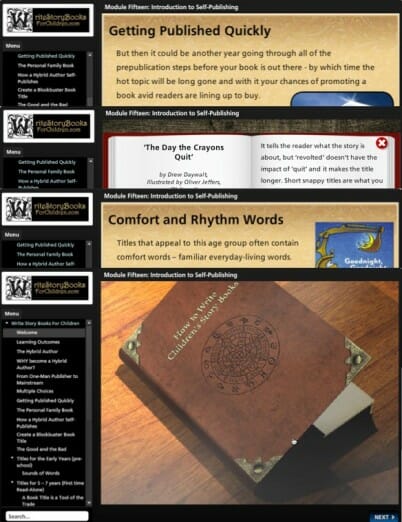
Module Sixteen: Cover Design & Working with Illustrators (click to open)
Module Overview
- Creating a blockbuster book cover
- A trick for designing a blockbuster book cover
- Cover designs for digital printing
- Short run book production
- Book cover design of fiction for the Early Years
- Book cover design of fiction for 5+ and 7+
- Book cover design of fiction for 8 – 11 years
- Book cover design of fiction for 11+ and young teens
- Book cover design of fiction for young adults 14+
- Book cover design of non-fiction titles
- A keen eye
- A good exercise
- Working with an illustrator
- Self-assessment test
- Much more!
Sample Screenshots
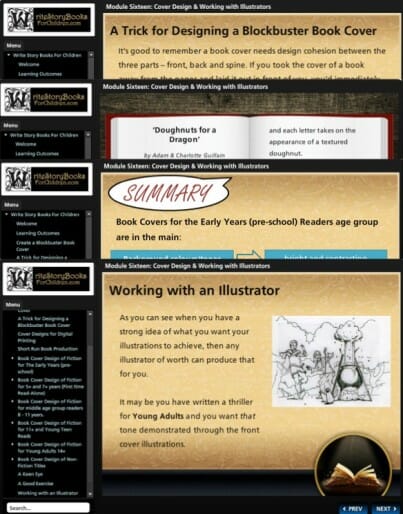
Module Seventeen: Digital Printing & e-book Essentials (click to open)
Module Overview
- The hybrid author and on-the-target marketing
- The Inside Story
- The ISBN question in the new world of publishing
- Who is the publisher?
- A global look at ISBN’s
- Technical info
- Creating blockbuster interiors
- Special story design for children’s books
- Your book is complete
- Print on demand
- The exciting world of eBooks
- Publishing to Kindle
- Publishing to other devices
- How to create PDF files for printing and downloading
- Self-assessment test
- Much more!
Sample Screenshots
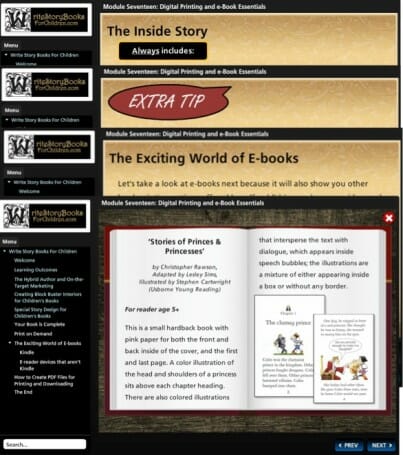
Module Eighteen: Effective Self-Marketing (click to open)
Module Overview
- Marketing children’s books for worldwide sales
- Building a reader fan base
- Your blog
- Making it easy-peasy
- How to add personality
- Powerful links
- A strong hook can sell your book
- Extra tips for the adventurous
- Audio books
- Video books
- YouTube
- Making a video or book trailer
- YouTube and extra income
- Post Script
- Final self-assessment test
- Much more!
Sample Screenshots

I had done other courses before and none were as informative or as easy to digest as this one. After completing the course, it took me three years to write (and re-write, re-write, re-write) my first novel, and I went back to the course modules several times over the years as a source of support.
I’m so pleased to tell you that my first novel was published (Young Adult Thriller- The Burning of Juniper Slaide) and on the back of its success, I have been offered a publishing deal with a traditional publisher (Rudling House) for two trilogies. My novel currently has 30 5* reviews on Amazon.co.uk and counting.
I have my first book signing event at Waterstones in Guildford, Surrey, in October. And I’m now busy finishing my second novel- and I’ve just logged back into your course to check something! So, thank you, so very much for providing a course which is full of essential information and nothing else, in simple language, beautifully presented, and without pretension.